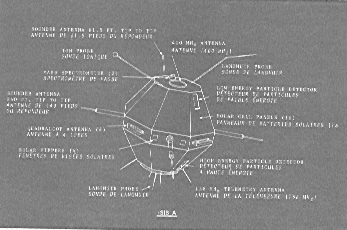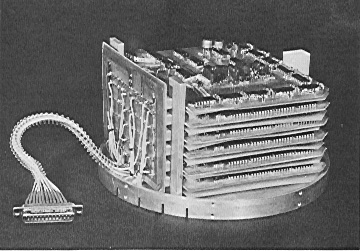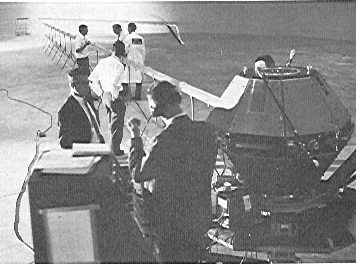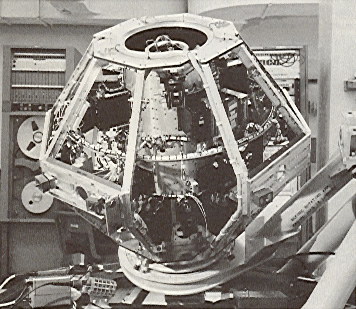
Science Dimension volume 1 issue 5 December 1969
| . |  |
| Above: Schematic of ISIS A Satellite. It has a diameter of 50 inches, a height of 41 inches and weighs 525 pounds. (NRC) |
Man has only a limited knowledge of the earth's environment. He knows most about the troposphere which contains about three-quarters of the mass of the atmosphere and extends to an altitude of from five to 10 miles. Less is known about the stratosphere, located 35 to 40 miles above the earth, and the ionosphere which lies above the stratosphere and extends to an altitude of some 600 miles. Even less is known about the magnetosphere which extends from the ionosphere out to about 40,000 miles and is the region in which the earth's magnetic field dominates the motion of electrically charged particles.
The National Research Council of Canada's Associate Committee on Space Research provides a national forum where scientists from universities, industry and government laboratories discuss matters of common interest in the field of space research. The term "space research" covers a broad spectrum of activities in which there is at present much international interest, both scientific and technological. Canadian scientists have participated actively in a number of areas in this highly competitive field and considerable success has been achieved.
The Committee has been particularly involved in promoting and coordinating space research using rockets and large balloons. Scientists in ten universities and two government agencies subsidized by NRC grants are carrying out space experiments in a variety of subjects, including X-ray astronomy, micrometeorite detection, studies of the composition and properties of the upper atmosphere and studies of the many effects, ranging from the Van Allen radiation belts to magnetic storms, that result from the bombardment of the earth by various kinds of radiation from the sun. Many of these studies involve co-operative experiments with university and government scientists participating equally and sharing common facilities. Development of techniques and hardware is conducted in the universities, industry and in government laboratories.
 |
. |
| Above: Electronic equipment used in Black Brant rockets to store and encode information received from particle detectors. (NRC) |
Scientists wishing to conduct a rocket or balloon experiment submit an experiment proposal to the Scientific Evaluation Panel of the Associate Committee on Space Research. The Panel performs an impartial evaluation of the proposal and either accepts or rejects it. The acceptable experiments are then integrated into the over-all program and the rocket, the payload 'engineering, and the launch are funded through NRC's Space Research Facilities Branch, while the experimental package is supplied by the scientists.
When ISIS B, Canada's fourth satellite, is launched in 1970, photometers developed by two Canadian universities with NRC grants, will be aboard. An NRC grant of $175,000 to the University of Calgary for 1969-70, has assisted research work on two flight models of an auroral scanning photometer. This experiment is designed to transmit data in a form which can be converted directly into pictures on an oscilloscope, providing a TV-type display of the aurora at specific wavelengths of light. During 1967-68 and 1968-69 the University received a total of $250,000 from the Council for this project.
A similar grant of $175,000 to the University of Saskatchewan for 196970, and previous grants of $150,000 during 1967-68 and 1968-69, have aided work- on an oxygen red line photometer. The experiment is designed to detect nightglow, twilightglow, dayglow, aurora, mid-latitude arcs and tropical arcs. Data obtained from these and other experiments should lead to interpretation of certain hitherto unexplained phenomena.
Space Research
| . |  |
| Above: One of the two 240-foot antennae on ISIS A being tested prioir to launch last January. In orbit, these NRC developed antennae uncurl like steel measuring tapes. They are on all Canadian satellites and were used on the U.S. Gemini space craft. (NRC) |
Two divisions of the Council have had instrument packages aboard rockets and satellites for studies of the upper atmosphere. Payloads aboard rockets from the Radio and Electrical Engineering Division are aiding in the study of plasma properties of high latitude aurora, micrometeorites and optical emissions in the upper atmosphere.
As part of a program to learn more al)out the magnetosphere, the Cosmic Ray Section of the Division of Physics, has flown instrument packages aboard the Alouettes and ISIS A satellites, and also on rockets launched from the Churchill Research Range. Purpose of the study is to investigate the nature of the interaction between slow moving electrons and protons from the sun (the solar wind) and the earth's magnetic field. It is this interaction that transfers particle energy from the sun to the earth's field and which is ultimately responsible for the Van Allen radiation belts, the aurora, magnetic storms, and ionospheric disturbances which cause communications blackouts.
Another objective is to determine the location and nature of acceleration mechanisms that operate within the earth's field which convert the low energy particles from the sun to much higher energy particles. The energization of particles in magnetized plasmas, i.e. the, conversion of magnetic energy to particle energy, is probably a fundamental process that occurs throughout the universe and plays an important role in solar flares, radio galaxies, pulsars, the generation of cosmic rays, etc. An understanding of the mechanisms that occur within the earth's magnetic field where they are relatively easily observed is expected to have wide applications in many areas o f astrophysics.
 |
. |
| Above: The ISIS B satellite being assembled in the clean room of RCA's Aerospace Facility in Montreal. (NRC) |
Analysis of data received from Alouette II seems to indicate that when the earth's magnetic axis is perpendicular to the solar wind flow, the outer regions of the radiation belt contract, suggesting that the strength of the interaction between the solar wind and the magnetic field is a maximum at these times.
"This in turn", says Dr. Ian McDiarmid, Head of the Cosmic Ray Section, "offers clues to the type of interaction that is taking place between the solar wind and the earth's field."
The location of acceleration mechanisms operating within the earth's magnetic field is being examined by determining how well the intensity of particles in one part of the magnetic field follows the intensity in another part at times of large magnetic disturbances, when it is known that particle energization occurs. Information relayed from Alouette II shows that for short periods during these disturbances, particle intensities are consistently higher on the midnight and morning sides of the earth than they are on the afternoon side. This has led to the conclusion that most of the acceleration that produces the more energetic electrons in the outer radiation belt occurs in a fairly limited region of space on the morning side of the earth, and a lower energy acceleration process operates at large distances from the earth in the midnight sector.
"Although it is still a little early for analysis of data from ISIS A", says Dr. McDiarmid, "information obtained from the Alouettes has already led to a better understanding of many of the properties of the particles in the Van Allen radiation belts, the particles associated with auroral events, and solar flare particles, the latter being a potential hazard to manned space flight."
Reprinted courtesy of the National Research Council of Canada